Useful properties of yellow carrots, and what is the difference from ordinary orange
Yellow carrots have long been popular all over the world, but in Russia this color is not often cultivated. The unusual color of the root crop is due to its chemical composition. Grow yellow carrots are easy, but you need to observe some nuances in caring for the plant.
The content of the article
- What it is
- Chemical composition, trace elements and vitamins, useful properties
- The main advantages and disadvantages of yellow carrots
- What is useful for the human body
- Yellow carrot varieties
- Features of planting and growing yellow carrots
- Harvesting and storage
- What can be the difficulties in growing
- Reviews of yellow carrots
- Conclusion
What it is
This is a plant of the Umbrella family with an elongated yellow root vegetable submerged in the ground. The tops are a bunch of bright green leaves located above the soil surface, the shape of which resembles feathers.
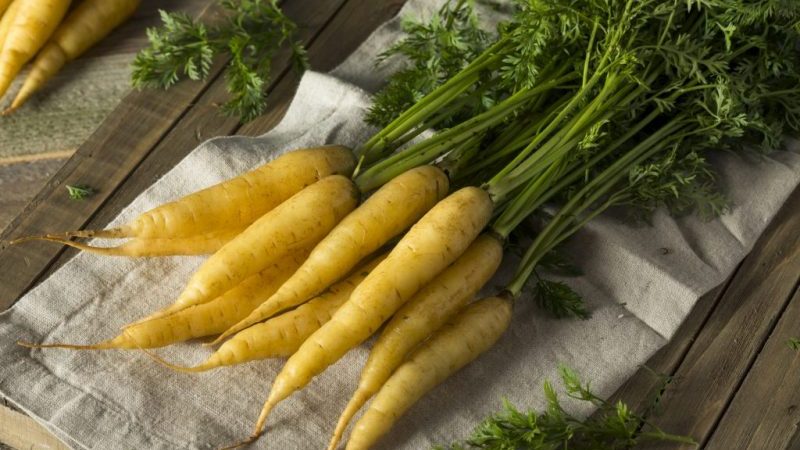
Why is she yellow
The color of a vegetable depends on its chemical composition.... Varieties in which pink and purple hues predominate contain a lot of anthocyanins, red and orange carrots contain more carotene, white carrots have practically no pigment, and xanthophyll and lutein, dyes of the carotenoid class, are responsible for the yellow color of the vegetable.
Origin and development
The homeland of yellow carrots is Central Asia, where roots of this color are even now found in the wild. It was they who formed the basis for the creation of modern varieties and hybrids.
What is the difference between yellow and orange carrots
The main differences between yellow carrots: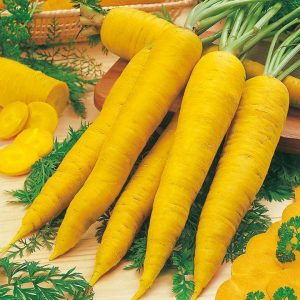
- root vegetable color;
- sweeter taste and higher calorie content;
- lower content of carotene and moisture;
- the presence of lutein in the chemical composition;
- the need for a warmer climate.
Chemical composition, trace elements and vitamins, useful properties
Yellow carrots contain:
- magnesium;
- potassium;
- calcium;
- iron;
- zinc;
- fluorine;
- iodine;
- sodium;
- phosphorus;
- vitamins of group B, A, C, E, H, PP, K;
- proteins;
- fats;
- carbohydrates;
- cellulose;
- carotene;
- Sahara;
- xanthophyll;
- lutein.
Lutein is good for vision and protects the retina of the eye from ultraviolet radiation, and xanthophyll blocks the development of cancer. Eating carrots is useful for people who have been diagnosed with urolithiasis and have problems with the bile ducts.
Calorie content and glycemic index
100 g of a vegetable contains 33 kcal. Raw carrots are characterized by a low glycemic index - 35 units, but after heat treatment they cause a sharp increase in blood sugar levels (GI - 75-85 units).
The main advantages and disadvantages of yellow carrots
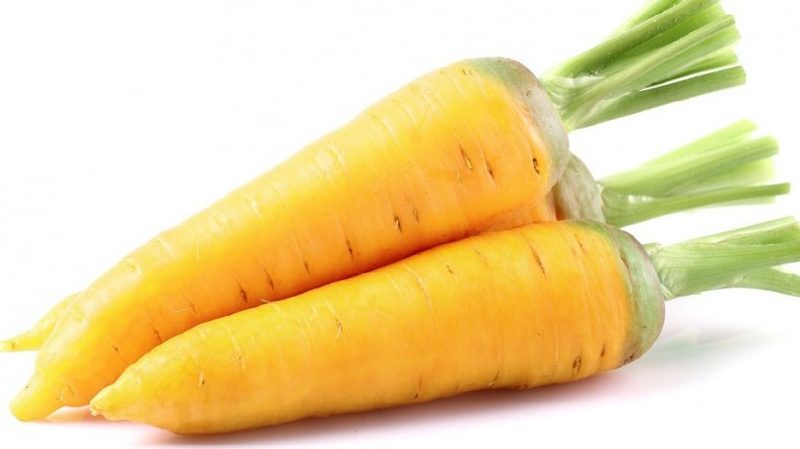
Pros:
- sweeter taste;
- reduced moisture content;
- well suited for heat treatment.
Minuses:
- the probability of acquiring poor planting material, which will give a low yield or the wrong color of root crops;
- exactingness to air temperature, especially in the Mirzoi 304 variety.
How it is used
Yellow carrots can be eaten fresh and added to absolutely all dishes, the preparation of which involves the use of carrots. It can be salads, vegetable fondues, soups, stews, pilaf, etc.This vegetable is often added to meat or fish dishes, preserves, marinades, and even sweet pastries.
The seeds and pulp of yellow carrots are used in folk medicine as a laxative, to cleanse the sweat glands, liver and gallbladder, for the prevention and treatment of vitamin deficiency and anemia, as a remedy against worms in children, for the treatment of burns, purulent wounds and sore throat.
What is useful for the human body
Like carrots of other colors, yellow roots improve metabolic processes in the body, have a positive effect on the work of the heart, have a urinary and choleretic effect, and help fight worms. Carrots have a positive effect on the condition and color of the skin, hair and nails, help in the formation of a correct bite and strengthen the tooth enamel.
Yellow varieties prevent the formation of cancer cells, since they contain a lot of xanthophyll, act as a means of preventing cardiovascular diseases and protect the retina.
Yellow carrot varieties
There are quite a few varieties of yellow carrots. The most popular ones are listed below.
Mirzoi 304
Table variety, bred in the 40s. XX century at the Uzbek Research Institute of Vegetable, Melons and Potatoes.
Root crops are yellow or light yellow, wide-cylindrical in shape with a blunt end, grow up to 10-15 cm in length and weigh 100-150 g. Leaves are dark green, medium-dense rosette. The pulp is juicy, sweet, the core is 30% of the vegetable.
The crop reaches its technical maturity in 113-120 days after planting, the yield is 200-300 c / ha.
The variety is demanding on temperature conditions and watering, under unfavorable conditions it is prone to cracking. Suitable for fresh consumption, canning, juice making.
Yellowstone
This is a US-bred early-ripening yellow carrot with a 70-85 day growing season. Forms fusiform roots, at least 18 cm long, bright lemon-yellow color.
Yellowstone carrots are characterized by high yields, excellent commercial qualities, the ability to adapt to different environmental conditions and resistance to diseases.
Solar yellow
An early maturing variety originally from America. The crop ripens in 85-90 days.
Leaves are weak, medium pubescence. Root crops are fusiform, reaching 15-20 cm in length and 3.5-4 cm in diameter. Suitable for fresh consumption and canning, not suitable for long-term storage.
Solar Yellow needs a long day of light and an air temperature of at least + 18 ° C.
Features of planting and growing yellow carrots
Cultivation of yellow carrots involves a standard algorithm consisting of planting material preparation, sowing, care and harvesting. Moreover, each stage has some nuances.
Preparing for landing
Seed preparation consists of several stages:
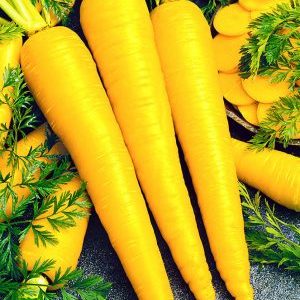
- Selection. The seeds are placed in warm water and mixed - low-quality grains will float.
- Heat treatment. The seeds are put into a cloth bag, dipped first in hot (+ 50 ° C), and then immediately in cold water, and then dried. This procedure reduces the risk of developing diseases.
- Growth stimulation. To improve germination, planting material is treated with growth stimulants, for example, "Fitosporin" or "Sodium humate"), dissolving 100 or 50 ml of the drug in 1 liter of water, respectively.
- Bubbling. The seeds are placed in a container with water for 24 hours, into which oxygen is supplied through a compressor, after which they are dipped in a potassium permanganate solution for 20 minutes, washed and dried.
The site is prepared in the fall: the earth is dug up, cleaned of plant residues and fed with manure.
Ground requirements
The culture grows well in light, loose and fertile soil with good moisture and air permeability.
Predecessors
It is best to plant carrots after potatoes, tomatoes, physalis, pumpkin, cucumbers, watermelons, zucchini, cabbage, strawberries, basil, tarragon, lettuce, spinach, legumes, onions, garlic.
Not recommended plant this crop in an area where dill, parsley, celery, beets or caraway used to grow.
Timing, scheme and landing rules
When landing carrots take into account 2 factors: air temperature (not lower than + 16 ° C) and the ripening period of the crop (on average 85-120 days). Sowing before winter is carried out in early November, before the onset of cold weather.
Important! Untimely planting in autumn will lead to early germination of seeds and subsequent freezing of seedlings.
Landing scheme:
- Prepare beds about 130 cm wide.
- Make 3-4 rows in them, keeping a distance of 20 cm between them.
- Place the seeds in the soil every 2 cm, deepening them 1.5 cm if the soil is heavy, or 2.5 cm if light.
- Sprinkle the seeds with a sand-peat mixture.
Growing features
Yellow carrots have the most requirements for temperature and humidity. For the Mirzoi 304 variety, high humidity and an air temperature of at least + 16 ° C are important, for Yellow Solar the minimum permissible temperature is + 18 ° C.
The nuances of care
Caring for yellow carrots consists of regular watering, fertilizing, as well as thinning seedlings and weeding the soil.
Watering mode
At an early stage of development, plants need abundant watering, but the soil should not be waterlogged. On average, carrots are watered every 3-4 days at the rate of 15-20 liters of water per 1 m².
Important! Water for irrigation must be settled and at ambient temperature.
Thinning and weed control
After the first two leaves appear on the shoots, the plants are thinned so that the distance between them is 3 cm.When 2 more leaves appear, the distance between the plants is increased to 5-6 cm.
Weed the soil as weeds grow, which negatively affect the development of carrots.
Top dressing
Top dressing is applied 2 times: 20 days after germination and 2 months after that.
Chicken manure or cow manure diluted in water with the addition of wood ash is used as organic fertilizers. From mineral dressing for yellow carrots, "Nitrofoska" (1 tbsp. L. Per bucket of water) and a solution of nitrate, urea and double superphosphate are suitable.
Disease and pest control
Phomosis and Alternaria can affect yellow carrots... For the treatment of these diseases, the plantings are treated with a 1% solution of Bordeaux liquid or fungicidal preparations - "Prozaro", "Falcon".
Carrot flies are the most dangerous pests. Insecticides, for example, "Aktara" or "Decis", will get rid of insects.
Harvesting and storage

It is important to harvest yellow carrots on time - if vegetables are in the soil for too long, they become tough and bitter.
How and when to collect
Most often, the harvest is harvested in June, but you can find out exactly whether the carrots are ripe or not, you can pull out a few root crops from the ground and examine them. If there are small roots, the crop can be harvested.
The collection is carried out on a dry sunny day, pulling carrots out of the soil by the tops.
Storage features and keeping quality
The collected carrots are carefully examined and sorted out: only specimens without mechanical damage and signs of rot and disease are suitable for storage.
High-quality root vegetables are dried in the sun or, in case of rain, under a canopy, then the tops are cut from them so that the carrots do not germinate, put in wooden or plastic boxes with holes for ventilation and put into a room with a maximum temperature of + 4 ° C. Shelf life is 6-8 months.
What can be the difficulties in growing
The main problems arising from the cultivation of yellow carrots:
- low productivity and small roots - the result of too thick sowing of seeds and insufficient thinning;
- cracking carrots indicates a lack of moisture and insufficient watering;
- curvature of fruits when using undiluted manure or bird droppings as fertilizers.
Reviews of yellow carrots
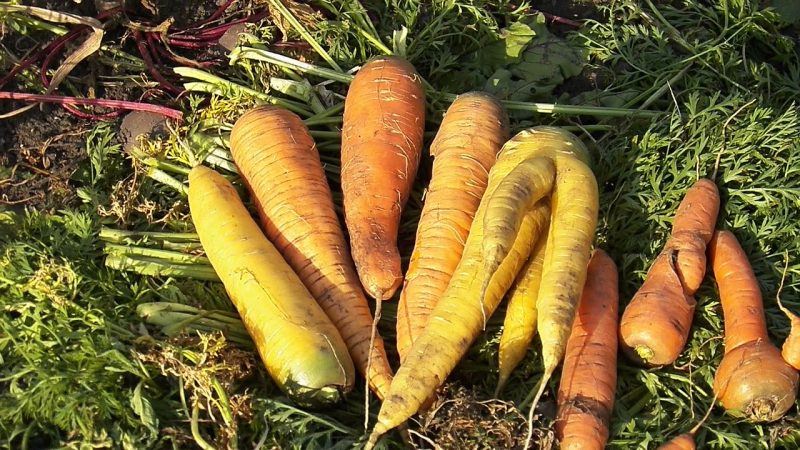
Experienced farmers speak positively of yellow carrots.
Elena, Tula: “I have been growing yellow carrots for several years, specifically Mirzoi 304. I tried it as an experiment, I wanted something unusual, but in the end the whole family liked this carrot. Even grandchildren eat it with pleasure - it is very sweet, they like it. "
Valentina, Ryazan: “I tried to grow several varieties of yellow carrots and ended up with Yellowstone. I really like the color - so bright, appetizing, I just want to eat it. Children gobble up with pleasure - beautiful and very sweet. Of course, it is quite capricious - a special temperature is needed and it is necessary to water often and a lot, but this is not a burden for me. "
Conclusion
Yellow carrots are one of the varieties of culture that differs from the usual orange vegetable not only in color, but also in taste and chemical composition. Even novice gardeners can cope with its cultivation, provided that the requirements that yellow carrots make for care and planting are met.